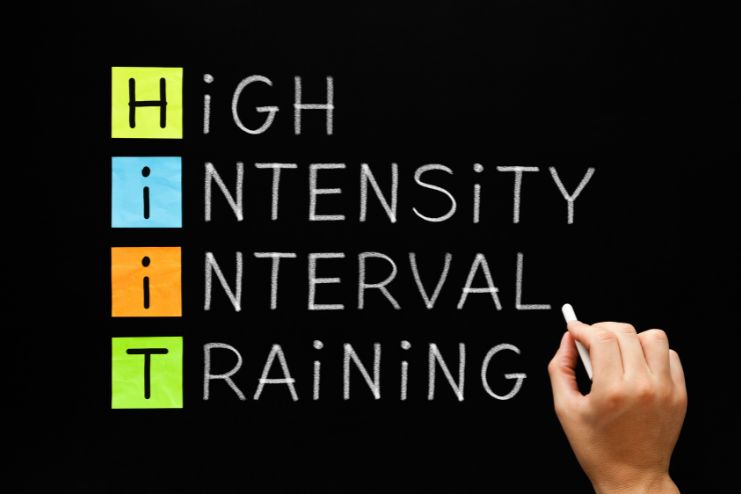Affiliate Disclaimer
Some links in this article are affiliate links. We may earn a small commission if you make a purchase through these links, at no extra cost to you. We only recommend products we find useful to our readersHigh-intensity interval Training (HIIT) and Endurance Training are well-liked, but different training approaches frequently take center stage in fitness.
Endurance training emphasizes consistent, moderate-intensity activity over a longer time, whereas HIIT consists of brief bursts of intensive exercise mixed with rest intervals.
Choosing between the two methods is essential for reaching particular fitness objectives because each has advantages.
Individual goals, such as cardiovascular health, muscle endurance, fat loss, and general athletic performance, will determine the best training approach. Knowing how HIIT and endurance training fit into your fitness goals can help you maximize results and optimize your workout regimen.
Read More: Fitness Challenges to Push Your Limits and Transform Your Body
Understanding HIIT

One kind of interval training exercise is HIIT. It consists of multiple rounds that alternate between brief intervals of lower-intensity movements and several minutes of high-intensity motions to raise the heart rate to at least 80% of one’s maximal heart rate.
As the name suggests, high-intensity interval training (HIIT) is difficult. Pushing your pace beyond your comfort zone elevates your aerobic workout to a new level.
Any aerobic exercise, such as jogging, stair climbing, rowing, or jumping rope, can be combined with HIIT.
It is possible to use body weight as the primary source of resistance without the need for extra equipment. Additionally, HIIT workouts typically don’t take up much room, making the format perfect for at-home training.
For busy people, HIIT is the ideal solution because it has been shown to increase aerobic capacity and burn calories without requiring the lengthy, tedious workouts that most people dread. Pushing your body and heart to their limits during the brief bursts of intense activity that comprise HIIT workouts can raise your heart rate and VO2 max. Try our routine below or contact a coach or personal trainer to design one.
As demonstrated by research, we adore high-intensity interval training, which offers numerous benefits. There are a ton of facts and scientific studies that support this fantastic workout approach, so if you’re searching for an excuse to give it a try, here it is!
- In a brief period, HIIT can burn a large number of calories.
- HIIT activity elevates your metabolic rate for hours.
- You can lose fat with HIIT.
- HIIT can lower blood pressure and heart rate.
Furthermore, HIIT is an effective workout for people looking for a well-rounded fitness approach because it increases muscle strength and endurance.
Exploring Endurance Training

Endurance training is a dynamic fitness program emphasizing precisely calibrated workouts to increase workout intensity and achieve the best possible results. By making conscious changes to their endurance levels, repetition patterns, and workout techniques, participants participate in a process that gradually improves their stamina and systematically tests their cardiovascular system.
Endurance training enables people to perform at their best by pushing themselves to the limit. Carefully modifying the endurance parameters efficiently stimulates participants’ cardiovascular systems, increasing their endurance capacity and overall physical resilience.
Running, cycling, swimming, and walking are examples of endurance exercises. Frequent endurance training improves circulation, energy levels, heart and lung function, and endurance for everyday tasks.
Asthma, heart disease, COPD, CHF, and other illnesses put them at increased risk for hospitalization and respiratory infections. Physical and occupational therapists are essential in helping people with these problems engage in safe and efficient endurance training.
The benefits of Endurance Training are:
Improved Cardiovascular Health: Exercises that require endurance, like swimming, cycling, or running, strengthen the heart muscle, boost oxygen delivery to tissues, and improve circulation.
Increased Stamina and Energy: Consistent endurance training improves stamina, energy levels, and endurance by increasing the body’s ability to create energy efficiently.
Weight management: Sports like cycling and running can help people reach and maintain a healthy body weight by increasing metabolism and burning extra calories.
Read More: Incredible Benefits of Cardio Based Exercise
Comparing Effectiveness
Individual fitness objectives are primary when deciding between HIIT and endurance training. HIIT is an excellent option for quickly losing weight and increasing cardiovascular fitness and muscle strength. Its quick, high-intensity intervals increase muscle endurance, burn calories effectively, and speed up metabolism. HIIT exercises also increase anaerobic capacity, which makes them perfect for athletes who require quickness and explosive power.
Conversely, endurance training is better for those who want to strengthen their heart, build their stamina, and maintain long-duration activities. Steady-state aerobic exercises are most suited for long-distance bikers, marathon runners, and anybody seeking to develop general cardiovascular endurance.
High-intensity interval Training (HIIT) is a more practical option for weight management and metabolic health than endurance training because it burns more calories in a shorter amount of time, significantly increases metabolism, and can result in more significant fat loss because of the “afterburn effect,” which causes your body to continue burning calories at higher rate even after the workout is over.
On the other hand, endurance exercise is beneficial for fat oxidation and total caloric expenditure over long periods of time, even if it burns fewer calories per minute. Long-duration aerobic exercise also benefits long-term weight management by enhancing insulin sensitivity and fat metabolism.
Read More: How to Boost Endurance Without Running: Top Workouts for Stamina
Practical Considerations

One of the most significant distinctions between HIIT and endurance training is the time needed. Any exercise that includes a brief interval of high-intensity activity followed by a rest or low-intensity exercise period is known as high-intensity interval training (HIIT).
Intense activity can last a few minutes to less than forty-five seconds. Before repeating the process, people relax or engage in mild exercise for a comparable amount of time.
Even though a full HIIT workout only takes 15 to 20 minutes, it offers numerous advantages. Its brief duration might make it a handy and efficient option for those who struggle to commit to longer sessions.
Endurance is one of the four categories of exercise, along with strength, balance, and flexibility. A balanced training regimen should ideally incorporate all four forms of exercise.
Many of your daily tasks become more manageable when you increase your endurance. Don’t jump into an exercise regimen if you’ve been sedentary for a while. Working your way up over time is crucial if you haven’t been active.
Build up gradually, starting with at least 10 to 15 minutes at a time.
Adults engage in moderate-to-intense physical exercise every week for at least 150 minutes around 2 1/2 hours. The simple objective of thirty minutes daily, five days a week, is easy to remember. There will be those who can do more. Setting reasonable goals based on your capabilities and state of health is crucial.
Tailoring Workouts to Goals
It’s critical to balance the advantages of HIIT and endurance training while customizing workouts depending on specific goals to optimize fitness outcomes. A HIIT-dominant practice that includes brief bursts of high-intensity movements can benefit people who want to lose weight and tone their muscles. Because of its effectiveness in increasing metabolism and burning calories, HIIT is perfect for people with little free time.
Endurance exercise ought to be the cornerstone for everyone looking to increase their cardiovascular stamina and endurance. Over time, steady-state long-distance running, cycling, swimming, or rowing improves the muscles, heart, and lungs.
Consistency is essential to attaining long-lasting outcomes, regardless of the strategy selected. Regular exercise frequency is more crucial than intensity alone for long-term fitness improvement.
To develop and sustain strength, endurance, and general health, people should strive for at least three to five weekly workouts, whether part of an endurance routine or a HIIT program. Over time, increasing frequency, duration, or intensity guarantees ongoing progress while lowering the chance of injury or burnout.
Read More: Debunking Strength Training Myths: What Every Woman Needs to Know
Conclusion
Both HIIT and endurance training have unique advantages and meet various fitness objectives. HIIT is perfect for people looking for brief, high-intensity workouts that optimize muscle endurance, metabolic increase, and calorie burn. It also improves cardiovascular health, strength training, and fat loss.
Conversely, endurance training emphasizes long-term, moderate-intensity exercise that improves heart health, fat metabolism, and stamina over extended periods. It is most appropriate for people who want to increase their cardiovascular resilience, long-distance performance, and aerobic capacity.
One’s lifestyle, physical capabilities, and fitness goals influence the decision between HIIT and endurance training. While endurance training may be preferred by those who prefer longer, steady-state activities, HIIT may be chosen by those who are time-constrained. A well-rounded strategy that combines aspects of both can provide extensive health advantages.
References
- https://nutritionsource.hsph.harvard.edu/high-intensity-interval-training/
- https://www.webmd.com/fitness-exercise/high-intensity-interval-training-hiit
- https://www.anytimefitness.com/ccc/getting-started/hiit-explained-what-is-high-intensity-interval-training/
- https://www.laramiefitness.com/programs/endurance-training
- https://uphillathlete.com/athlete-stories/endurance-training-in-unconventional-places/
- https://www.medicalnewstoday.com/articles/327474#overview
- https://bellinghamevo.com/how-long-does-it-take-to-see-results-from-hiit-the-science-behind-high-intensity-interval-training-hiit/
- https://www.heart.org/en/healthy-living/fitness/fitness-basics/endurance-exercise-aerobic
In this Article


























